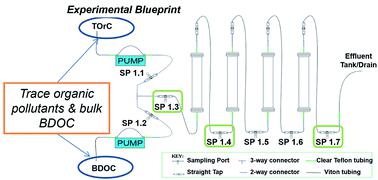当前位置:
X-MOL 学术
›
Environ. Sci.: Processes Impacts
›
论文详情
Our official English website, www.x-mol.net, welcomes your
feedback! (Note: you will need to create a separate account there.)
Microbial genetic potential for xenobiotic metabolism increases with depth during biofiltration
Environmental Science: Processes & Impacts ( IF 4.3 ) Pub Date : 2020-08-30 , DOI: 10.1039/d0em00254b Dong Li 1, 2, 3, 4, 5 , Jonathan O. Sharp 1, 2, 3, 4, 5 , Jörg E. Drewes 1, 2, 3, 4, 5
Environmental Science: Processes & Impacts ( IF 4.3 ) Pub Date : 2020-08-30 , DOI: 10.1039/d0em00254b Dong Li 1, 2, 3, 4, 5 , Jonathan O. Sharp 1, 2, 3, 4, 5 , Jörg E. Drewes 1, 2, 3, 4, 5
Affiliation

|
Water infiltration into the subsurface can result in pronounced biogeochemical depth gradients. In this study, we assess metabolic potential and properties of the subsurface microbiome during water infiltration by analyzing sediments from spatially-segmented columns. Past work in these laboratory set-ups demonstrated that removal efficiencies of trace organic pollutants were enhanced by limited availability of biodegradable dissolved organic carbon (BDOC) associated with higher humic ratios and deeper sediment regions. Distinct differences were observed in the microbial community when contrasting shallow versus deeper profile sediments. Metagenomic analyses revealed that shallow sediments contained an enriched potential for bacterial growth and division processes. In contrast, deeper sediments harbored a significant increase in genes associated with the metabolism of secondary metabolites and the biotransformation of xenobiotic water pollutants. Metatranscripts further supported this trend, with increased potential for metabolic attributes associated with the biotransformation of xenobiotics and antibiotic resistance within deeper sediments. Furthermore, increasing ratios of humics in feed solutions correlated to enhanced expression of genes associated with xenobiotic biodegradation. These results provide genetic support for the interplay of dissolved organic carbon limitation and enhanced trace organic biotransformation by the subsurface microbiome.
中文翻译:

外源生物代谢的微生物遗传潜力随着生物过滤过程中深度的增加而增加
水渗入地下会导致明显的生物地球化学深度梯度。在这项研究中,我们通过分析空间分段柱中的沉积物来评估水渗透过程中地下微生物组的代谢潜力和特性。这些实验室设置中的过去工作表明,可生物降解的可溶性有机碳(BDOC)的利用率有限,且腐殖比更高,沉积物区域更深,从而提高了痕量有机污染物的去除效率。对比浅层与浅层对比时,在微生物群落中观察到明显差异较深的剖面沉积物。元基因组学分析表明,浅层沉积物具有丰富的细菌生长和分裂过程的潜力。相反,较深的沉积物与次生代谢物的代谢和异源水污染物的生物转化有关的基因显着增加。元转录本进一步支持了这一趋势,在较深的沉积物中,与异生物素的生物转化和抗生素抗性相关的代谢属性潜力增加。此外,饲料溶液中腐殖质比例的增加与与异源生物降解相关的基因的表达增强有关。这些结果为溶解的有机碳限制和地下微生物组增加的痕量有机生物转化之间的相互作用提供了遗传学支持。
更新日期:2020-09-03
中文翻译:

外源生物代谢的微生物遗传潜力随着生物过滤过程中深度的增加而增加
水渗入地下会导致明显的生物地球化学深度梯度。在这项研究中,我们通过分析空间分段柱中的沉积物来评估水渗透过程中地下微生物组的代谢潜力和特性。这些实验室设置中的过去工作表明,可生物降解的可溶性有机碳(BDOC)的利用率有限,且腐殖比更高,沉积物区域更深,从而提高了痕量有机污染物的去除效率。对比浅层与浅层对比时,在微生物群落中观察到明显差异较深的剖面沉积物。元基因组学分析表明,浅层沉积物具有丰富的细菌生长和分裂过程的潜力。相反,较深的沉积物与次生代谢物的代谢和异源水污染物的生物转化有关的基因显着增加。元转录本进一步支持了这一趋势,在较深的沉积物中,与异生物素的生物转化和抗生素抗性相关的代谢属性潜力增加。此外,饲料溶液中腐殖质比例的增加与与异源生物降解相关的基因的表达增强有关。这些结果为溶解的有机碳限制和地下微生物组增加的痕量有机生物转化之间的相互作用提供了遗传学支持。











































 京公网安备 11010802027423号
京公网安备 11010802027423号